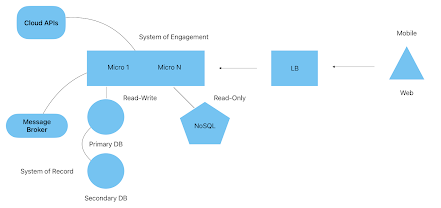A primary goal of cloud architecture is to provide a cloud computing environment that supports a flexible, scalable, and reliable platform for the delivery of cloud services.
In terms of layers, cloud architecture may include infrastructure, platform, and software layers. These are often referred to as IaaS, PaaS, and SaaS. Infrastructure has the physical servers, storage devices, and networking that are required to support cloud services. Platform refers to the software frameworks and tools that are used to develop and deploy cloud applications. And software is all about the applications and services built on top of infrastructure and platform, that are provided to end-users.
If we really boil it down to an essence, it's possible to define a cloud architecture comprised of 5 core elements:
1. Load Balancer
2. Microservices
3. System of Record
4. System of Engagement
5. Messaging
1. Load Balancer
To distribute incoming network traffic evenly and to prevent overloading of any single resource, a Load Balancer provides high availability (HA) through fail-over and request distribution by an algorithm like round-robin. Rules are added here to send traffic to the nodes of a cluster uniformly, or based on their ability to respond.
2. Microservices
Microservices allow APIs to be deployed fast and often. As a core platform layer, microservices provide a way for APIs to be combined when there's a need to correlate data from different sources. They isolate the lower layers of the platform from end-user applications and they support long term growth in development team size, plus the number of applications and services can grow here as well, in isolation from each other.
3. System of Record
A System of Record (SOR) is the primary source of data used as the source of truth for a particular business process or application. A database, a file system, or any other software system that stores and manages data becomes a system of record. It is a unified view of critical business data, accurate and up-to-date. A source of truth has a disaster recovery plan as well as backups.
4. System of Engagement
All user interaction with applications and services delivered by the platform happens through a System of Engagement (SOE), for users to login, search, and interact with the cloud services provided. To better engage with customers and stakeholders, the SOE provides them with personalized, interactive experiences that are tailored to their needs and preferences.
5. Messaging
Finally, a messaging system is needed for service-to-service communication and coordination between applications. A messaging system adds the facilities to create, send, receive, and to read messages.
These elements could be selected from a cloud catalog, or installed into a cloud provider such as AWS, Azure, or GCP. For example, the following open-source software could be deployed into a cloud platform, as an implementation of the 5-service cloud architecture:
1. HA Proxy
2. Kubernetes
3. MySQL
4. Elastic Search (ELK)
5. Kafka
There's no limit to the number of cloud services that can be designed, implemented, deployed, operationalized, and exposed to users as cloud-native applications, using any 2 or more of these platform services.
In defining a cloud architecture model, architects lay a foundation for future product development. Through a 5-service cloud architecture, we setup product teams, engineering teams, and infrastructure teams to design, build, and deliver an unlimited range of applications and services to users and businesses, built on top of a system of sub-systems.

No comments:
Post a Comment